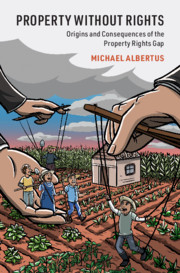Book contents
- Property without Rights
- Cambridge Studies in Comparative Politics
- Property without Rights
- Copyright page
- Contents
- Figures
- Tables
- Acknowledgments
- 1 Introduction
- 2 Conceptualizing and Measuring the Property Rights Gap
- 3 The Political Origins of the Property Rights Gap
- 4 Evidence on the Rise and Fall of Property Rights Gaps in Latin America
- 5 Consequences of the Property Rights Gap
- 6 Opening and Closing a Property Rights Gap in Peru
- 7 The Long-Term Consequences of Peru’s Property Rights Gap
- 8 Property Rights Gaps around the World
- 9 Conclusion
- Book part
- References
- Index
- Other Books in the Series (continued from page iii)
6 - Opening and Closing a Property Rights Gap in Peru
Published online by Cambridge University Press: 22 December 2020
- Property without Rights
- Cambridge Studies in Comparative Politics
- Property without Rights
- Copyright page
- Contents
- Figures
- Tables
- Acknowledgments
- 1 Introduction
- 2 Conceptualizing and Measuring the Property Rights Gap
- 3 The Political Origins of the Property Rights Gap
- 4 Evidence on the Rise and Fall of Property Rights Gaps in Latin America
- 5 Consequences of the Property Rights Gap
- 6 Opening and Closing a Property Rights Gap in Peru
- 7 The Long-Term Consequences of Peru’s Property Rights Gap
- 8 Property Rights Gaps around the World
- 9 Conclusion
- Book part
- References
- Index
- Other Books in the Series (continued from page iii)
Summary
This chapter examines land reform and property rights in Peru, which was characterized by high landholding inequality and semi-feudal landlord peasant relations until the 1960s, with roots in Spanish colonization. A transition to democracy brought initial land reform, and then a military coup in 1968 began massive land redistribution. Peasants received land through cooperatives but not property rights such as land titles. Property rights were strengthened slightly under democracy in the 1980s, but major land titling only began when Peru was facing a major economic crisis and the Shining Path insurgency in the early 1990s. President Fujimori closed Congress via an autogolpe and then worked with the International Monetary Fund and World Bank to stabilize the economy and begin a nationwide land formalization program. This chapter uses process tracing, original archival documents, and interviews to detail the economic and political conditions that led to the origins and closing of Peru’s property rights gap, focusing on democracy, dictatorship, foreign pressure, and the role of landed elites, peasants, and political elites.
Keywords
- Type
- Chapter
- Information
- Property without RightsOrigins and Consequences of the Property Rights Gap, pp. 203 - 226Publisher: Cambridge University PressPrint publication year: 2021

